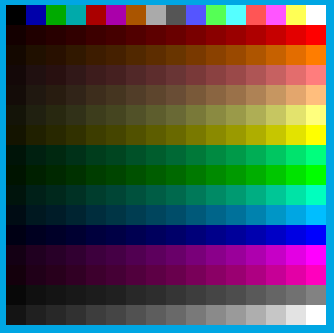

In practice, in order to avoid this problem, most images don't use the full range of 256 colors. Since an 8-bit color display can't display two images with different color maps at the same time, it is usually impossible to display two different 8-bit images on the same such display at the same time. Issues ĭue to the nature of the 8-bit system, most images have different color maps. For example, both Mars Exploration Rovers used an 8-bit grayscale format for navigation imaging. Many different image types such as GIF and TIFF use an 8-bit color system to store data.Įven though it is now outdated for most consumer applications, 8-bit color encoding can still be useful in imaging systems with limited data bandwidth or memory capacity. Developed in 1987 by IBM, the VGA interface supported a maximum resolution of 640x480 pixels. Most notably, the VGA standard for graphical interface uses an 8-bit color. Many scanners use an 8-bit grey scale as their standard.Wearable OS smartwatches with ambient displays.The Research Machines 380Z computer equipped with a High Resolution Graphics board.The Tiki 100 personal computer (limited to 16 simultaneous color display).

8-bit color was used in many different applications including: Usage īecause of the low amount of memory and resultant higher speeds of 8-bit color images, 8-bit color was a common ground among computer graphics development until more memory and higher CPU speeds became readily available to consumers. The more accurate median cut algorithm resorts and divides colors to find the median of different color groups resulting in a more accurate final color map. Popular approaches for creating these maps (also known as palettes) include the popularity algorithm which chooses the 256 most common colors and creates a map from them. There could be different groupings of colors that make evenly spreading the colors out inefficient and likely to misrepresent the actual image.Īn alternative approach is to use a palette, with each of the 256 possible indexes pointing towards a larger color space (ex: 256 colors chosen from 4096).īecause the color map doesn't need to have every color in it and just needs to accurately represent the more color dense image, an arbitrary color can be assigned to each of the 256 available color indexes on the map. This creates a so called 3-3-2 8-bit color image, arranged like on the following table: The simplest form of quantization is to simply assign 3 bits to red, 3 bits to green and 2 bits to blue, as the human eye is less sensitive to blue light. Color quantization is the process of creating a color map for a less color dense image from a more dense image. In order to turn a true color 24-bit image into an 8-bit image, the image must go through a process called color quantization. For example, you can enter the same weight for all three colors - 0.8-bit color, with three bits of red, three bits of green, and two bits of blue. These values can be changed in the calculator above. Thus, the formula for calculating the new values of R, G and B (all three are the same) from the existing values is as follows: These coefficients are written in the sRGB standard - this is how the luminosity of color is calculated when switching from sRGB to the CIE XYZ color space. The human eye is most sensitive to green, so the largest weight is used for green - 0.7152, the least sensitive to blue, with a weight of 0.0722, and red uses a weight of 0.2126. Since colors with different wavelengths are perceived differently by the human eye, different weights are assigned to different colors to calculate the luminosity of a point. A color image is thus represented by 256 shades of gray. The standard RGB model allocates 1 byte for each color, respectively, after the conversion, the pixel can have only on of the,. To convert a color image to a grayscale image in the RGB model you need to replace different red, green, and blue values for a given pixel with a single value that characterizes the brightness or luminosity of the pixel. Conversion of a color image to a grayscale image


 0 kommentar(er)
0 kommentar(er)
